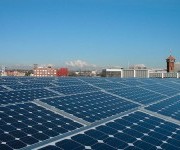This is part three of my interview with Michael Liebreich, head of Bloomberg New Energy Finance. See part one and part two.

Michael Liebreich. (Photo by Mike Lawn/Bloomberg.)
Q. The big story in solar right now is the flood of cheap, silicon-based panels from China and the subsequent wiping out of non-silicon solar companies in the U.S. and Germany (including, most famously, Solyndra). How will that play out?
A. A few years ago, China bet on blasting the existing stage of technology with money and process engineering, and American companies bet on the next generation, the funky stuff like CIGS. You could say that the Chinese definitely won this round. (Though I suspect First Solar, being a very well-run and effective company, may argue that it ain’t over yet.)
You’ve got an existing overcapacity which will probably take most of next year to absorb. We’ll probably see some solar manufacturing migrating away from China, accelerated by the U.S. trade finding. At the moment the Chinese have over-invested; you’re seeing bankruptcies.
I don’t think it’s over for manufacturing in the U.S., Germany, or Japan, because [solar] is not purely a commodity. I still don’t think we’ve seen the endpoint in terms of building-integrated, high-efficiency products. We’re a couple of rounds in to a 12-round fight. It’ll be a while before you see the final shape of the solar industry.
It’s interesting: The U.S. has never been a manufacturer of solar panels at scale. It did the specialist technology for pocket calculators and satellites. It was really Europe and Asia [that manufactured at scale]. One unfortunate element to the trade tension is that the U.S. exports more silicon than it imports solar panels, and yet it’s engaged in a trade war, which is extremely bad for those people employed at the installation end, it’s bad for U.S. scientists developing [intellectual property] to license to China, it’s just bad all around. You can understand the politics, but if the U.S. is not competitive in manufacturing, then it seems unfortunate to lay the blame for that at the door of this industry. Apple doesn’t make iPads here; they’re quite content to import those from China. What’s different about solar? The only difference is, it’s subsidized.
But look at the situation in Germany. Through feed-in tariffs, they’ve subsidized solar panels to the tune of something like 100 billion euros, and a big chunk of that went to China. But you know what? They’re getting their own back. Now China has subsidized manufacturing with all this cheap capital, and the Germans have got cheap solar! It swings around.
We almost need a global industrial policy. But we’re playing it for short-term, national, political (not even economic) advantage.
A country engages in dumping to destroy a [competitor’s] industry and then raise prices and extract rents. But what industry, other than First Solar? Unless you want to argue that Solyndra was a robust business that was only destroyed because of the perfidious Chinese … but that’s absurd. That company was founded on the premise that silicon would remain at $450/kilo, despite the fact that before the whole boom, silicon was a $23/kilo. I don’t want to mock Solyndra too much — good people came up with the idea and good people backed it — but it was always a Hail Mary bet. It was new technology, new form factor, new distribution channel — it was a multi-miracle business. And frankly it never should have been debt-funded. That was just a distortion of loan guarantees for early-stage technology companies. There were lots of mistakes made, but it’s not right to force it into the paradigm of the anti-dumping response.
Q. Do you think silicon prices will come back up and non-silicon solar panels will eventually become competitive?
A. I don’t think the price of silicon is going to come up much. What will happen is, the excess stock will be liquidated, there will be people manufacturing at marginal costs for a while, and the glut will be absorbed. But meanwhile, other manufacturers will come in, people will shut down the old lines and build new ones. I’m just not seeing panel prices materially come up.
On the contrary, I think we’re going to see continued improvement in racking technologies, installation technologies, the whole balance-of-systems. [Rooftop solar installations] still look like PCs, not like Macs. It’s not elegantly done. When you really start to pluck out costs is when they’re fully building-integrated. I see continued improvement, plenty far to go in cost reductions.
The non-silicon stuff isn’t as efficient, but it’s competitive on a dollar-per-watt basis. I think we’ll see much better understanding of when you do what, which niches. It’s clear that on a rooftop, efficiency matters, because you’ve got limited space. You’re not as worried about [internal rate of return], you’re worried about [net present value]. I’ve only got one roof; if you told me I could earn 200 percent a year, but it’s only a few bucks, I don’t want someone crawling around on the roof doing it. I’m worried about the value I can get out of leasing my roof.
But when you’ve got no space constraints, you want the [internal rate of return] to work. I think we’ll see specialization rather than monoculture, one company or technology winning everything. There’ll be a space for concentrated photovoltaics, solar thermal, thin-film, non-silicon and silicon, and whatever else comes along. It’s all a question of which locations and which applications.
Look at the improvement in gas-turbine efficiency between 1990 and now, and then ask where clean energy technology will be in 20 years. There are people who act as though wind, for instance, has reached the end of its experience curve — it’s just ridiculous. Improvements in cost and performance scale with the doubling of experience — it’s a logarithmic function, not a linear function.
Q. What do you make of the new NREL study showing that it’s possible to get to 80 percent clean energy by 2050?
A. I haven’t read the study closely, in a sense because I already know what it says: It can be done; there are costs involved. Eighty percent is expensive, and it’s a lot more upfront investment. The key thing about these technologies — geothermal, solar, wind, hydro, marine — you spend up front and then there’s no fuel costs. You’re shifting to upfront payment, so you’re very sensitive to interest rates, and right now the financial markets are pretty poor. The financial stresses, particularly in Europe, have kept net interest rates high despite very low central bank rates.
You get into something of an ideological discussion, because those who do not want to go that direction will say, “there, you see, in order to deal with all the intermittency issues, you’ve got to spend tons of money and have overcapacity.” But then the people who do want to go that direction will say, “at least we know then what we’re spending. We don’t have hidden health costs, we don’t have volatility costs, we don’t have increasing gas costs, we don’t have defense costs.” So what would you rather have, the cost devil you know, or the cost devil you don’t know, which pops up all over the place in unpredictable parts of your economy?
It should be an economic discussion, because you can quantify those things, but it isn’t. It tends to descend into ideology.




